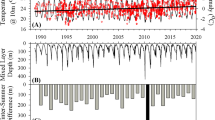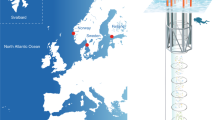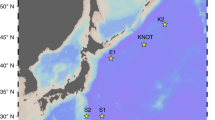Abstract
The Arctic and subarctic shelf seas, which sustain large fisheries and contribute to global biogeochemical cycling, are particularly sensitive to ongoing ocean acidification (that is, decreasing seawater pH due to anthropogenic CO2 emissions). Yet, little information is available on the effects of ocean acidification on natural phytoplankton assemblages, which are the main primary producers in high-latitude waters. Here we show that coastal Arctic and subarctic primary production is largely insensitive to ocean acidification over a large range of light and temperature levels in different experimental designs. Out of ten CO2-manipulation treatments, significant ocean acidification effects on primary productivity were observed only once (at temperatures below 2 °C), and shifts in the species composition occurred only three times (without correlation to specific experimental conditions). These results imply a high capacity to compensate for environmental variability, which can be understood in light of the environmental history, tolerance ranges and intraspecific diversity of the dominant phytoplankton species.
This is a preview of subscription content, access via your institution
Access options
Access Nature and 54 other Nature Portfolio journals
Get Nature+, our best-value online-access subscription
$29.99 / 30 days
cancel any time
Subscribe to this journal
Receive 12 print issues and online access
$209.00 per year
only $17.42 per issue
Buy this article
- Purchase on Springer Link
- Instant access to full article PDF
Prices may be subject to local taxes which are calculated during checkout


Similar content being viewed by others
References
Pörtner, H.-O. et al. in Climate Change 2014: Impacts, Adaptation, and Vulnerability (eds Field, C. B. et al.) 411–484 (IPCC, Cambridge Univ. Press, 2014).
Falkowski, P. G., Barber, R. T. & Smetacek, V. Biogeochemical controls and feedbacks on ocean primary production. Science 281, 200–206 (1998).
Rost, B., Zondervan, I. & Wolf-Gladrow, D. Sensitivity of phytoplankton to future changes in ocean carbonate chemistry: Current knowledge, contradictions and research needs. Mar. Ecol. Prog. Ser. 373, 227–237 (2008).
Connell, S. D. & Ghedini, G. Resisting regime-shifts: the stabilising effect of compensatory processes. Trends Ecol. Evol. 30, 513–515 (2015).
Ghedini, G., Russell, B. D. & Connell, S. D. Trophic compensation reinforces resistance: herbivory absorbs the increasing effects of multiple disturbances. Ecol. Lett. 18, 182–187 (2015).
Miller, G. H. et al. Arctic amplification: can the past constrain the future? Quat. Sci. Rev. 29, 1779–1790 (2010).
Wassmann, P. & Reigstad, M. Future Arctic Ocean seasonal ice zones and implications for pelagic-benthic coupling. Oceanography 24, 220–231 (2011).
Arrigo, K. R., van Dijken, G. & Pabi, S. Impact of a shrinking Arctic ice cover on marine primary production. Geophys. Res. Lett. 35, L19603–L19603 (2008).
AMAP Assessment 2013: Arctic Ocean Acidification 99 (Arctic Monitoring and Assessment Programme, Oslo, Norway, 2013).
Qi, D. et al. Increase in acidifying water in the western Arctic Ocean. Nat. Clim. Change 7, 195–199 (2017).
Thoisen, C., Riisgaard, K., Lundholm, N., Nielsen, T. G. & Hansen, P. J. Effect of acidification on an Arctic phytoplankton community from Disko Bay, West Greenland. Mar. Ecol. Progress Ser. 520, 21–34 (2015).
Duarte, C. M. et al. Is ocean acidification an open-ocean syndrome? Understanding anthropogenic impacts on seawater pH. Estuaries Coasts 36, 221–236 (2013).
Steinacher, M., Joos, F., Frölicher, T. L., Plattner, G. K. & Doney, S. C. Imminent ocean acidification in the Arctic projected with the NCAR global coupled carbon cycle-climate model. Biogeosciences 6, 515–533 (2009).
Popova, E. E., Yool, A., Aksenov, Y., Coward, A. C. & Anderson, T. R. Regional variability of acidification in the Arctic: a sea of contrasts. Biogeosciences 11, 293–308 (2014).
Gao, K. & Campbell, D. A. Photophysiological responses of marine diatoms to elevated CO2 and decreased pH: a review. Funct. Plant Biol. 41, 449–459 (2014).
Riebesell, U. & Tortell, P. D. in Ocean Acidification (eds Gattuso, J. P. & Hansson, L.) 99–121 (Oxford Univ. Press, Oxford, 2011).
Bach, L. T. et al. Dissecting the impact of CO2 and pH on the mechanisms of photosynthesis and calcification in the coccolithophore Emiliania huxleyi. New Phytol. 199, 121–134 (2013).
Wolf, K., Hoppe, C. J. M. & Rost, B. Resilience by diversity: Large intraspecific differences in climate change responses of an Arctic diatom. Limnol. Oceanogr. 63, 397–411 (2017).
Riebesell, U. & Gattuso, J.-P. Lessons learned from ocean acidification research. Nat. Clim. Change 5, 12–14 (2015).
Gao, K., Helbling, E. W., Häder, D.-P. & Hutchins, D. A. Responses of marine primary producers to interactions between ocean acidification, solar radiation, and warming. Mar. Ecol. Prog. Ser. 470, 167–189 (2012).
Boyd, P. W. & Hutchins, D. A. Understanding the responses of ocean biota to a complex matrix of cumulative anthropogenic change. Mar. Ecol. Prog. Ser. 470, 125–135 (2012).
Engel, A. et al. CO2 increases 14C primary production in an Arctic plankton community. Biogeosciences 10, 1291–1308 (2013).
Coello-Camba, A., Agustí, S., Holding, J., Arrieta, J. M. & Duarte, C. M. Interactive effect of temperature and CO2 increase in Arctic phytoplankton. Front. Mar. Sci. 1, 49 (2014).
Holding, J. M. et al. Temperature dependence of CO2-enhanced primary production in the European Arctic Ocean. Nat. Clim. Change 5, 1079–1082 (2015).
Hussherr, R. et al. Impact of ocean acidification on Arctic phytoplankton blooms and dimethyl sulfide concentration under simulated ice-free and under-ice conditions. Biogeosciences 14, 2407–2427 (2017).
Hoppe, C. J. M. et al. Iron limitation modulates ocean acidification effects on Southern Ocean phytoplankton communities. PLoS ONE 8, e79890 (2013).
Tortell, P. D. et al. CO2 sensitivity of Southern Ocean phytoplankton. Geophys. Res. Lett. 35, L04605 (2008).
Rokitta, S. D. & Rost, B. Effects of CO2 and their modulation by light in the life-cycle stages of the coccolithophore Emiliania huxleyi. Limnol. Oceanogr. 57, 607–618 (2012).
Gao, K. et al. Rising CO2 and increased light exposure synergistically reduce marine primary productivity. Nat. Clim. Change 2, 519–523 (2012).
Hoppe, C. J. M., Holtz, L.-M., Trimborn, S. & Rost, B. Ocean acidification decreases the light-use efficiency in an Antarctic diatom under dynamic but not constant light. New Phytol. 207, 159–171 (2015).
Arrigo, K. R. & van Dijken, G. L. Secular trends in Arctic Ocean net primary production. J. Geophys. Res. Oceans 116, C09011 (2011).
Zeebe, R. E. & Wolf-Gladrow, D. A. CO 2 in Seawater: Equilibrium, Kinetics, Isotopes (Elsevier Science, Amsterdam, 2001).
Smith, F. A. & Raven, J. A. Intracellular pH and its regulation. Annu. Rev. Plant Physiol. 30, 289–311 (1979).
Kingsolver, J. G. The well‐temperatured biologist. Am. Nat. 174, 755–768 (2009).
Eppley, R. W. Temperature and phytoplankton growth in the sea. Fish. Bull. 70, 1063–1085 (1972).
Collins, M. et al. in Climate Change 2013: The Physical Science Basis (eds Stocker, T. F. et al.) Ch. 12 (IPCC, Cambridge Univ. Press, 2013).
Sett, S. et al. Temperature modulates coccolithophorid sensitivity of growth, photosynthesis and calcification to increasing seawater pCO2. PLoS ONE 9, e88308 (2014).
Leu, E. et al. Arctic spring awakening – Steering principles behind the phenology of vernal ice algal blooms. Prog. Oceanogr. 139, 151–170 (2015).
Pančić, M., Hansen, P. J., Tammilehto, A. & Lundholm, N. Resilience to temperature and pH changes in a future climate change scenario in six strains of the polar diatom Fragilariopsis cylindrus. Biogeosciences 12, 4235–4244 (2015).
Schulz, K. G. et al. Temporal biomass dynamics of an Arctic plankton bloom in response to increasing levels of atmospheric carbon dioxide. Biogeosciences 10, 161–180 (2013).
Tortell, P. D. et al. Inorganic carbon uptake by Southern Ocean phytoplankton. Limnol. Oceanogr. 53, 1266–1278 (2008).
Feng, Y. et al. Interactive effects of iron, irradiance and CO2 on Ross Sea phytoplankton. Deep Sea Res. I 57, 368–383 (2010).
Trimborn, S. et al. Iron sources alter the response of Southern Ocean phytoplankton to ocean acidification. Mar. Ecol. Prog. Ser. 578, 35–50 (2017).
Hoppe, C. J. M., Schuback, N., Semeniuk, D. M., Maldonado, M. T. & Rost, B. Functional redundancy facilitates resilience of Subarctic phytoplankton assemblages towards ocean acidification and high irradiance. Front. Mar. Sci. 4, 229 (2017).
Trimborn, S., Brenneis, T., Sweet, E. & Rost, B. Sensitivity of Antarctic phytoplankton species to ocean acidification: growth carbon acquisition, and species interaction. Limnol. Oceanogr. 58, 997–1007 (2013).
Hofmann, G. E. et al. High-frequency dynamics of ocean pH: a multi-ecosystem comparison. PLoS ONE 6, e28983 (2011).
Ardyna, M. et al. Shelf-basin gradients shape ecological phytoplankton niches and community composition in the coastal Arctic Ocean (Beaufort Sea). Limnol. Oceanogr. 62, 2113–2132 (2017).
Carmack, E. & Wassmann, P. Food webs and physical–biological coupling on pan-Arctic shelves: Unifying concepts and comprehensive perspectives. Prog. Oceanogr. 71, 446–477 (2006).
MacIntyre, H. L., Kana, T. M. & Geider, R. J. The effect of water motion on short-term rates of photosynthesis by marine phytoplankton. Trends Plant Sci. 5, 12–17 (2000).
Matsuoka, A., Hill, V., Huot, Y., Babin, M. & Bricaud, A. Seasonal variability in the light absorption properties of western Arctic waters: parameterization of the individual components of absorption for ocean color applications. J. Geophys. Res. Oceans 116, C02007 (2011).
Waldbusser, G. G. & Salisbury, J. E. Ocean acidification in the coastal zone from an organism’s perspective: multiple system parameters, frequency domains, and habitats. Annu. Rev. Mar. Sci. 6, 221–247 (2014).
Schaum, C. E., Rost, B. & Collins, S. Environmental stability affects phenotypic evolution in a globally distributed marine picoplankton. ISME J. 10, 75 (2015).
Hunt, G. L. Jr. et al. Advection in polar and sub-polar environments: Impacts on high latitude marine ecosystems. Prog. Oceanogr. 149, 40–81 (2016).
Degerlund, M. & Eilertsen, H. C. Main species characteristics of phytoplankton spring blooms in NE Atlantic and Arctic waters (68–80° N). Estuaries Coasts 33, 242–269 (2009).
Hegseth, E., Svendsen, H. & von Quillfeldt, C. H. in Ecology of Fjords and Coastal Waters 45–72 (eds Skjoldal, H. R., Hopkins, C., Erikstad, K. E., Leinaas, H. P.) (Elsevier Science, Amsterdam, 1995).
Hegseth, E. N. et al. in The Ecosystem of Kongsfjorden, Svalbard (eds Hop, H. & Wiencke, C.) (Springer, New York, in the press).
Collins, S., Rost, B. & Rynearson, T. A. Evolutionary potential of marine phytoplankton under ocean acidification. Evol. Appl. 7, 140–155 (2014).
Garrison, D. in Marine Plankton Life Cycle Strategies (eds Steidinger, K. A. & Walker, L. M.) (CRC Press, Boca Raton, 1984).
Jones, S. E. & Lennon, J. T. Dormancy contributes to the maintenance of microbial diversity. Proc. Natl Acad. Sci. USA 107, 5881–5886 (2010).
Kremp, A. et al. Diverse seed banks favour adaptation of microalgal populations to future climate conditions. Environ. Microbiol. 18, 679–691 (2016).
Sjöqvist, C. O. & Kremp, A. Genetic diversity affects ecological performance and stress response of marine diatom populations. ISME J. 10, 2755–2766 (2016).
Browman, H. I. Applying organized scepticism to ocean acidification research. ICES J. Mar. Sci. 73, 529–536 (2016).
Harley, C.D.G. et al. Conceptualizing ecosystem tipping points within a physiological framework. Ecol. Evol. 7, 6035–6045 (2017).
Kroeker, K. J., Micheli, F. & Gambi, M. C. Ocean acidification causes ecosystem shifts via altered competitive interactions. Nat. Clim. Change 3, 156–159 (2013).
Hoppe, C. J. M. et al. Resistance of Arctic phytoplankton to ocean acidification and high irradiance. Polar Biol. 41, 399–413 (2018).
Scheffer, M. et al. Early-warning signals for critical transitions. Nature 461, 53–59 (2009).
Connell, S. D. et al. Testing for thresholds of ecosystem collapse in seagrass meadows. Conserv. Biol. 31 1196–1201 (2017).
Dickson, A. G., Sabine, C. L. & Christian, J. R. Guide to Best Practices for Ocean CO 2 Measurements (North Pacific Marine Science Organization, Sidney, British Columbia, 2007).
Brewer, P. G., Bradshaw, A. L. & Williams, R. T. in The Changing Carbon Cycle – A Global Analysis (eds Trabalka, J. R. & Reichle, D. E.) 358–381 (Springer, New York, 1986).
Stoll, M. H. C., Bakker, K., Nobbe, G. H. & Haese, R. R. Continous-flow analysis of dissolved inorganic carbon content in seawater. Anal. Chem. 73, 4111–4116 (2001).
Pierrot, D. E., Lewis, E. & Wallace, D. W. R. MS Exel Program Developed for CO 2 System Calculations (Oak Ridge National Laboratory, US Department of Energy, Oak Ridge, 2006).
Mehrbach, C., Culberson, C. H., Hawley, J. E. & Pytkowicz, R. M. Measurement of the apparent dissociation constants of carbonic acid in seawater at atmospheric pressure. Limnol. Oceanogr. 18, 897–907 (1973).
Millero, F. J. et al. Dissociation constants for carbonic acid determined from field measurements. Deep Sea Res. I 49, 1705–1723 (2002).
Dickson, A. G. Standard potential of the reaction: AgCl(s) + ½ H2(g) = Ag(s) + HCl(aq), and the standard acidity constant of the ion HSO4 - in synthetic seawater from 273.15 to 318.15 K. J. Chem. Thermodyn. 22, 113–127 (1990).
Knap, A., Michaels, A., Close, A., Ducklow, H. & Dickson, A. G. Protocols for the Joint Global Ocean Flux Study (JGOFS) Core Measurements (UNESCO, 1996).
Nielsen, E. S. The interaction of photosynthesis and respiration and its importance for the determination of 14C-discrimination in photosynthesis. Physiol. Plant. 8, 945–953 (1955).
Tomas, C. R. & Hasle, G. R. Identifying Marine Phytoplankton (Academic Press, New York, 1997).
Acknowledgements
We thank the crew, captain and scientific teams of the Canadian Arctic-GEOTRACES 2015 campaign on-board the GCCS Amundsen. Further, the AWIPEV station teams of 2014 and 2016 are acknowledged for their exceptional logistics support. Kings Bay AS provided laboratory facilities for the Svalbard (KF) experiments. L. Wischnewski, M. Kiel, D. Semeniuk, J. Mol, H. Thomas and M. Soon are thanked for laboratory assistance. We thank D. Wolf-Gladrow for his help with the statistical analysis. C.J.M.H. thanks P. Assmy and the Norwegian Polar Institute for providing the perfect working environment to write a first version of this manuscript. Funding for this work was provided by the AWI Strategy Fund and from the Climate Change and Atmospheric Research programme of the Natural Sciences and Engineering Research Council of Canada. C.J.M.H. received additional funding through a Feodor Lynen Research Fellowship granted by the Alexander von Humboldt Foundation.
Author information
Authors and Affiliations
Contributions
C.J.M.H., N.S., P.D.T. and B.R. designed the study; C.J.M.H., K.K.E.W., N.S. and P.D.T. carried out the experiments; C.J.M.H. carried out the sample and data analyses; C.J.M.H. wrote the manuscript with contributions from K.K.E.W., N.S., P.D.T. and B.R.
Corresponding author
Ethics declarations
Competing interests
The authors declare no competing interests.
Additional information
Publisher’s note: Springer Nature remains neutral with regard to jurisdictional claims in published maps and institutional affiliations.
Supplementary information
Supplementary Information
Supplementary Tables I1–I6, Supplementary Figure I1
Rights and permissions
About this article
Cite this article
Hoppe, C.J.M., Wolf, K.K.E., Schuback, N. et al. Compensation of ocean acidification effects in Arctic phytoplankton assemblages. Nature Clim Change 8, 529–533 (2018). https://doi.org/10.1038/s41558-018-0142-9
Received:
Accepted:
Published:
Issue Date:
DOI: https://doi.org/10.1038/s41558-018-0142-9
This article is cited by
-
Phosphate limitation and ocean acidification co-shape phytoplankton physiology and community structure
Nature Communications (2023)
-
Tipping points of marine phytoplankton to multiple environmental stressors
Nature Climate Change (2022)
-
Simulated ocean acidification altered community composition and growth of a coastal phytoplankton assemblage (South West coast of India, eastern Arabian Sea)
Environmental Science and Pollution Research (2022)
-
The role of a changing Arctic Ocean and climate for the biogeochemical cycling of dimethyl sulphide and carbon monoxide
Ambio (2022)
-
Short-term effects of winter warming and acidification on phytoplankton growth and mortality: more losers than winners in a temperate coastal lagoon
Hydrobiologia (2021)



